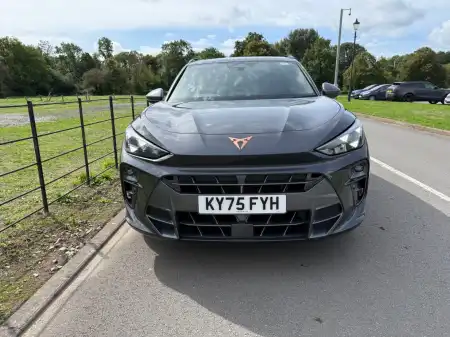- Charismatic looks inside and out
- Fairly engaging handling
- It’s comfortable
- Boot space could be better
- It could be less pricey
- Logic should be as prioritised as style
Introduction

If you're in search of a premium vehicle that prioritises style above all else, an Alfa Romeo may very well top your car-buying shortlist, writes Regit’s car reviewer, Tim Barnes-Clay.
This manufacturer is part of Stellantis, the parent company that encompasses numerous well-known brands, including Fiat, Chrysler, Renault, and Vauxhall.
Although Stellantis is based in the Netherlands and managed from the United States, Alfa Romeo retains its Italian spirit, with its headquarters firmly rooted in Italy.
When considering iconic cars from Italy, names like Lamborghini and Ferrari immediately spring to mind. However, Alfa Romeo presents a more accessible buying alternative that truly captures the essence of Italian automotive craftsmanship.
Alfa Romeo vehicles also shine in terms of performance, excelling in both acceleration and handling. So, when it came to appealing to its traditional enthusiasts with the introduction of an SUV, it was bound to be a challenging conversation.
Nevertheless, the Tonale rose hard and fast to the occasion, maintaining the Alfa spirit. Now, at nearly four years old, the model has been refreshed.
While mid-life updates seldom bring about radical changes, it'll be interesting to see if the updated Tonale becomes an even more appealing choice for motorists.
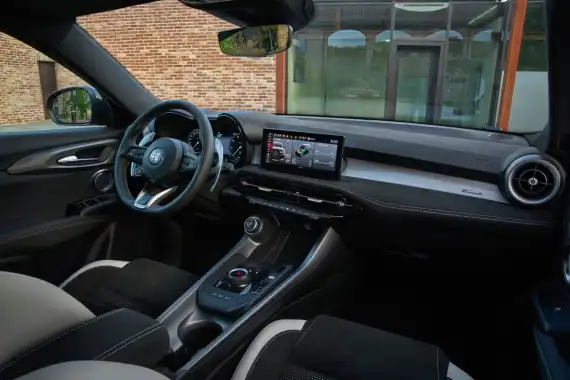
The Tonale preserves much of its predecessor's appearance, which is typical for a mid-life facelift. However, it cleverly manages to infuse a sense of nostalgia with design cues from the past.
At the front, there's a fresh bumper inspired by the iconic 33 Stradale. The lower grille has undergone a significant revision – instead of the rounded trapezoid shape, it now resembles a 'bowtie' design. The famous Alfa shield, or Scudetto, has also been revamped, featuring a more aggressive stance and horizontal lines. Meanwhile, the triple headlights remain on either side, now more seamlessly integrated into the Scudetto.
One change from earlier models is the repositioning of the number plate, which is now centred rather than offset - a familiar arrangement found on many Alfa Romeos in the past. This adjustment greatly enhances the vehicle's aesthetics! Newly designed alloy wheels give it a refreshed look, and the SUV boasts a wider track, while the overall shape remains similar to the previous version.
The rear of the Tonale is still characterised by its rounded silhouette, complete with a roof spoiler above the rear windscreen and dual exhausts positioned lower down, one on each side. Between the exhausts and the rear window, the taillights connect through a horizontal light bar that elegantly frames the rounded Alfa badge at the centre of the tailgate. Previously, it was noted that the front was more aggressive than the rear, and this distinction is further emphasised with the latest updates.
The interior has also been tweaked as part of the facelift, which is welcome, given it was criticised before for not feeling special enough. When you buy an Italian car, you're forking out for style, so while the old interior wasn't bad, it lacked the je ne sais quoi Alfa Romeo shoppers expect.
There are still many similarities – everything is the same shape, but the subtle details, such as the stitching running along the dashboard, which adds a more refined touch, make all the difference. A lovely-to-use rotary dial now replaces the pug-ugly gear lever, too – and the centre console has been spruced up a bit. Build quality has also been improved, with everything feeling properly screwed down, whereas the predecessor had parts that felt rather fragile and cheap. Additionally, there are more soft-to-the-touch materials.
The new Alfa Romeo Tonale is available in various trim levels. The base model boasts 17-inch wheels, a 10.25-inch infotainment touchscreen with Apple CarPlay/Android Auto, digital radio, voice control, a 12.3-inch digital instrument cluster, and adaptive cruise control. Additional features include a rear-view camera, keyless entry/go, dual-zone climate control, full LED headlights and taillights, as well as adaptive high beam.
The Ti trim includes black window surrounds, fender badging, heated and ventilated eight-way power-adjustable leather seats, a heated steering wheel, and aluminium paddle shifters.
The top-tier Veloce variant comes with 19-inch alloys, mudguard badging, full LED matrix headlights, red Brembo brake callipers, twin chrome tailpipes (in the PHEV version), and a black rear Tonale logo, along with DSV (Dual-Valve Electronic) adaptive suspension.
At launch, there is also a distinctive Sport Speciale trim, on test here, that features 20-inch alloys, silver accents, gloss-black Brembo brake callipers, and striking black and white Alcantara seats.
The 10.25-inch infotainment touchscreen has been enhanced, offering sharp graphics and an intuitive menu layout. While it may not be the most responsive, it holds its own in the premium segment and isn't particularly sluggish.
Unfortunately, one feature that's been omitted is the rotary dial found in some other Alfa models, meaning you need to tap the screen while on the move. Nevertheless, the voice control operates effectively. Furthermore, the 12.3-inch digital instrument display has also seen improvement, with clearer visuals for the clock, fuel gauge, and (in the PHEV model) battery indicators.
On The Road
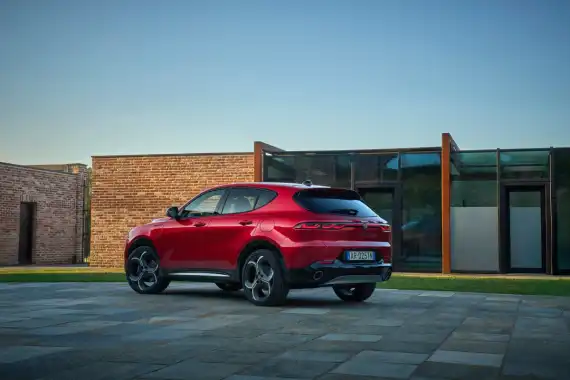
Handling & Performance
There are a couple of powertrain options. The mild-hybrid (MHEV) version features a 1.5-litre four-cylinder turbocharged petrol engine that generates 175PS, representing an increase over the previous model, and is mated to a seven-speed dual-clutch automatic transmission.
On the other hand, the plug-in hybrid (PHEV) comes with a smaller 1.3-litre four-cylinder petrol engine, but it is paired with a considerably larger electric motor - and, combined, the SUV produces 270PS. This is a slight reduction from the previous output due to updated emissions regulations. The PHEV also features a six-speed automatic gearbox and an all-wheel-drive system, referred to as 'Q4' in Alfa terminology.
Here, we’re assessing the PHEV in, as mentioned, the Sport Speciale trim, which boasts a 0-62mph time of just 6.6 seconds. The way it accelerates feels seamless, with an undeniable sense of ample power at the ready, making motorway merges or overtaking straightforward. While the engine noise may not be particularly exhilarating at full throttle, this is common among many PHEVs with smaller petrol mills; however, some premium rivals do offer a more refined auditory experience.
In contrast, the MHEV version takes 1.9 seconds longer to reach 62mph, which is still good given the PHEV’s performance advantage. The MHEV allows for brief periods of engineless driving, albeit only over limited distances. In contrast, the PHEV is specifically designed to operate without the engine at times, achieving this effectively.
The PHEV’s transmission shifts quickly and smoothly, although there were initial doubts regarding its driving dynamics when Alfa Romeo first introduced the Tonale. But while the Tonale doesn’t quite match the performance of other Alfa models, it’s admirable that Alfa Romeo has made significant improvements, offering precise steering, a well-balanced steering wheel, and plenty of feedback that aids when cornering.
Our test vehicle is fitted with adaptive dual-stage valve (DSV) suspension, which does an okay job of reducing body roll compared with models lacking this feature. Nevertheless, it still doesn’t quite measure up to its premium competitors.
Ride comfort is fairly acceptable, especially given that our test PHEV was equipped with 20-inch alloys. However, at higher speeds, it doesn’t feel as stable as some of its opponents.
The PHEV includes regenerative braking, which feels robust, particularly in more aggressive settings, while generally maintaining consistent performance.

Space & Practicality
The Tonale boasts a welcoming and comfortable interior. It's easy to achieve a supportive driving position, thanks to the extensive adjustment range of the seats and steering wheel, along with adjustable lumbar support, and seats that provide excellent side support during cornering.
The front windscreen pillars are not particularly wide and are swept back, ensuring good forward visibility. However, the rear pillars are considerably thicker, exacerbated by the rounded edge of the rear side window, which limits essential over-the-shoulder visibility.
As a result, all models come fitted with front, rear, and side parking sensors, as well as a rear-view camera. Additionally, there's an option to upgrade to a 360-degree surround view camera, now enhanced with a higher resolution and a 'drone view' feature.
There's ample legroom and headroom in the front seats, even for taller drivers. However, opting for the panoramic roof does slightly reduce headroom, so it's wise to consider your height before deciding. What's more, the cabin isn't as spacious as some contenders, which could lead to a bit of a squeeze for elbow room.
In the rear, a flat floor allows passengers to spread out a bit more. However, the sloping roofline impacts headroom, while legroom is adequate but not as generous as in some competitors - three adults will find long journeys less comfy.
The new Tonale offers a boot capacity of 500 litres, which shrivels to 385 litres in the PHEV variant. With the rear seats folded over in a 60:40 configuration, the capacity expands to 1,550 litres (or 1,430 litres for the PHEV), and the boot shape is practical, allowing for efficient use of space. Additionally, the boot floor is height-adjustable, enabling the removal of the loading lip. However, this feature is unavailable if you choose the PHEV, as the batteries are situated beneath the floor.
Ownership
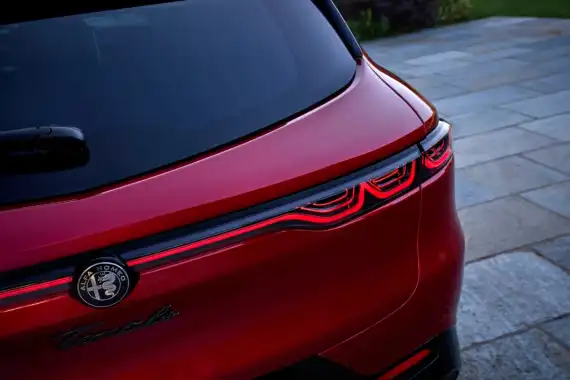
Running Costs
The Tonale PHEV boasts a 15.5kWh battery, which provides a claimed all-electric range of 38 miles. In contrast, the MHEV features a significantly smaller 0.8kWh battery.
When using a dedicated 7.4kW home wallbox, the Tonale PHEV can recharge its batteries from empty to full in approximately two and a half hours. If you opt to plug it into a standard mains socket, the process usually takes around six and a half hours.
Officially, the PHEV claims to achieve around 300mpg, but to achieve such figures, regular charging is essential. The Alfa emits between 77 and 83g/km of CO2, depending on the precise specifications. If the battery is depleted, expect fuel economy to drop to 30-35mpg. Also, bear in mind the relatively small 42.5-litre fuel tank. In comparison, the MHEV delivers figures of 47-49mpg and 128-133g/km.
For those considering a company car, the PHEV stands out as the superior choice; however, its emissions place it in the 12% Benefit-in-Kind tax bracket, whereas some competitors manage to fall into the lower 8% band.
Alfa Romeo has a reputation for unreliability, but despite this rather negative legacy, the company's recent track record has shown signs of improvement.
Verdict
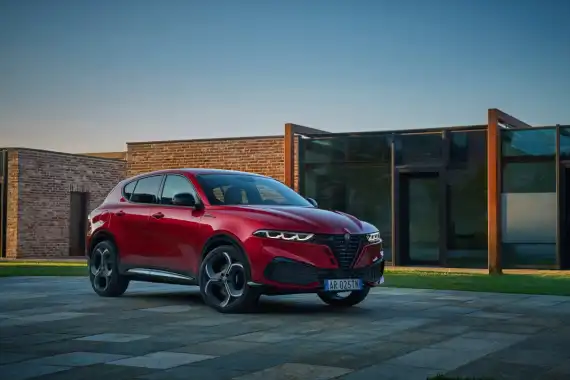
At first glance, the latest Tonale is an attractive option. It offers engaging handling that surpasses expectations for its size, features a comfortable and practical interior, and is well-equipped with striking aesthetics.
However, premium rivals manage to achieve all of this while providing greater practicality and superior value, boasting more cabin space and storage. Additionally, the plug-in hybrid variant has even more limited boot capacity.
When it comes to engine refinement, competitors have the upper hand, and the Tonale’s pricing doesn’t correspond to its shortcomings, particularly when stacked against German models. While it's not a poor choice, there are better alternatives available at a lower cost, especially given its positioning in the premium car market.
We would recommend sticking with the base model, which includes all the essentials and more – the higher trims are high-priced, particularly as their competitors offer similar features for less.
The new Tonale is very decent, but it doesn’t quite measure up, and the reality is that this SUV is more about its style and Italian flair than its overall quality. Thus, it’s a purchase driven by emotion rather than logic. In many ways, that’s part of the allure of buying an Alfa!



